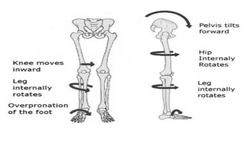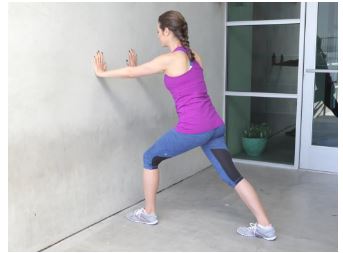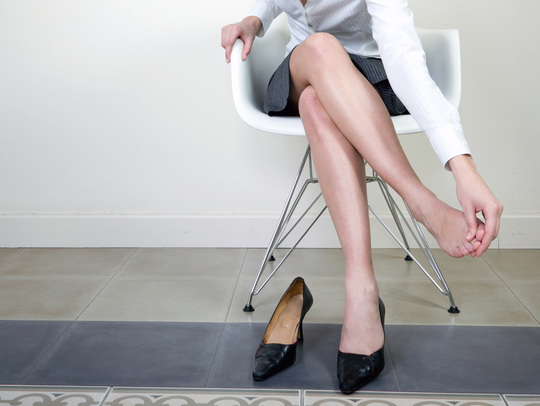 Most people are puzzled when a podiatrist draws a link between these two seemingly unrelated structures however the reality is, they very well could be impacting on one another. In fact, about 25% of all the bones in the body is found in the feet and a misalignment in these structures can easily be responsible for problems further up the body. I often equate the feet to being like shock absorbers in a car. They act to disperse forces from the road equally to enable a smooth drive. If the shocks are worn, damaged or not working optimally, the ride would be bumpy and steering would become difficult. Along these lines, podiatrists expertly assess the biomechanical functioning of the feet and isolate potential problems in alignment or function which may be contributing to symptoms in areas other than the feet. This thorough examination may involve further referral to specialists such as chiropractors and physiotherapists for further assessment of the back pain but it serves as a good stepping stone for people to understand how vital feet are to the functioning of the body and more importantly the benefits of taking care of one's feet. A number of studies have shown that the impact lower back pain has on the healthcare sector has been gradually on the rise in Australia with figures in 2001 showing $9.17 billion dollars being spent on treatments. One of the issues research brings up is the problem of misdiagnosis. A similar study also showed that amongst a group of 97,279 soldiers tested, those who had flat feet were twice as likely to report lower back pain. In fact when you think about it, during an average day walking, the total forces experienced on your feet can equal to hundreds of tons. Whilst there are many factors that may contribute to the development of lower back pain, when you consider the influence of feet, a number of common factors are seen as culprits. Whilst this is not an exhaustive list, it is for podiatrists a warning sign that patients may be heading down the road of pain and discomfort.
What can be done? A biomechanical assessment of the foot alignment and function can help determine the level of intervention needed. By identifying exactly what part of the foot alignment is associated with the described symptoms a podiatrist can work to correct the alignment of the feet and reduce the back pain. Some common interventions that may be applied for flat feet may include: custom or off the shelf orthotics, specialist footwear advice, sports taping and padding of the feet and current footwear. These will all aim to position the feet in a ‘neutral’ position whereby excessive pronation is controlled. Whilst flat feet may never be ‘fixed’, the consequences that they carry on the body most certainly can be reduced and reversed to ensure a patient's life is not interrupted by pan. 2) Poor footwear choices Footwear plays an important part in the functioning of feet. Choose unsupportive shoes when you need support, and your feet will suffer the consequences. Whether for fashion, work requirements or affordability, people often opt to wear shoes that may be doing them more harm than good. Much like the effect of foot posture, poorly fitted or unsupportive shoes can enable excessive motion of the foot during weight bearing which may mean instability that can lead to injury. With people spending hours on their feet every day, improper or worn out shoes can affect the natural gait cycle. Overly flat shoes (‘flats’) generally offer no support, this may lead to insufficient shock absorption through the joints of the feet and may result in jarring of the spine or tightening of the lower back muscles. How can a Podiatrist help? A podiatrist can offer specialist advice on your current footwear and will be able to tell you whether they are appropriate for your foot type or not. I have in the past had to convince patients to let go of their beloved NIKE’s or ballet flats much to their dismay. However the same people who have followed advice have also thanked me weeks later for the advice often telling me that ‘their feet have never felt better’. Unfortunately there is no single ‘magic type of shoe’ for every foot as everyone's feet are unique. This highlights the importance of having your feet assessed to obtain specific advice. There are three general characteristics that can be used as a guide for purchasing new footwear:
3) Tightness in the calf muscles Whilst many muscles may be directly involved in lower back pain symptoms, where the feet are concerned the calf muscles are undeniably linked to the onset of these symptoms. The calf muscles are made up of 2 separate muscles which form the achilles tendon. They function to place the foot in a plantar-grade (downwards) position which is important when walking to push off the ground with your toes. Calf tightness can be caused by a number of factors including:
How can calf tightness be reduced? Whenever I see patients who present to the clinic with tight calves, I offer a number of treatment methods to help alleviate the tightness. Often the tightness is due to simple soft tissue contracture other times it is in consequence of foot alignment. Foot alignment problems can be corrected using an orthotic but outside of that:Massage
Towel/band/belt stretch
 Wall stretch
Whilst there is no one single ‘best approach’ for alleviating symptoms caused by problematic feet, seeing a podiatrist can be the first step to achieving your goals and a pain-free day to day life.  Dr Anel Kapur delievers an outstanding clinical podiatric care to all clients. He has earnt himself an exceptional reputation among his clients for his attention to detail, gentle approach and depth of knowledge. Dr Anel Kapur is available for appointments Monday and Saturday. Bookings are available online or contact receptions on 9542 3330
1 Comment
1/19/2017 04:27:41 am
I never truly minded the pain in my feet. I thought to myself that it would just go away after some sleep. I was never aware of its dire consequences. I guess that I really have to go to a check up some time. You should never really ignore body pains and see professionals as soon as possible to avoid long term effects.
Reply
Leave a Reply. |
Archives
June 2021
|
|
Contact Details
Call 9542 3330
99A Loftus Ave, Loftus NSW 2232 Hours Monday & Wednesday 8am - 6pm Saturday: 8am - 12pm Early morning or later evening available by appointment Our reception is available for walk-ins on Monday, Wednesday & Saturday. Or by telephone 7 days. |



 RSS Feed
RSS Feed